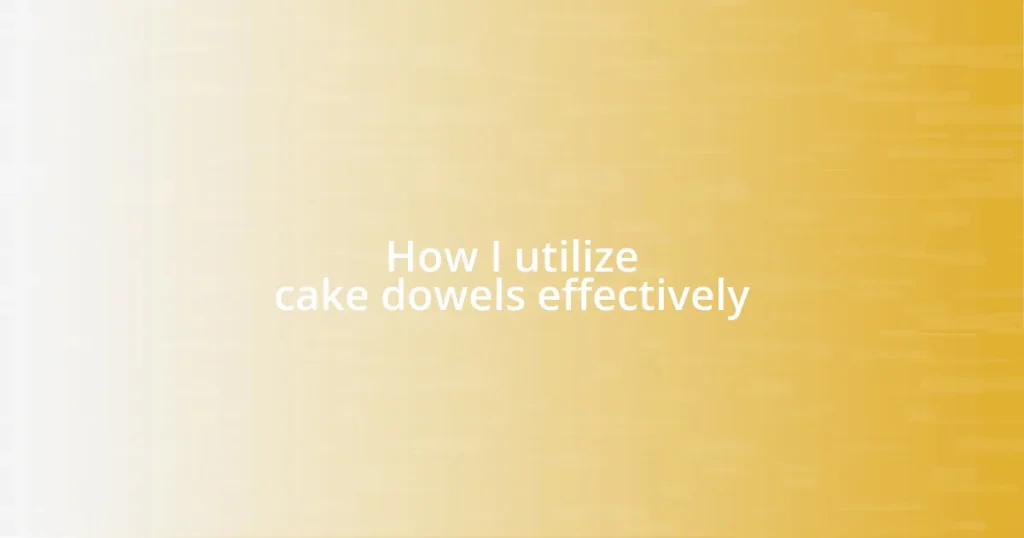Key takeaways:
- Using cake dowels is essential for the structural integrity of multi-tiered cakes, preventing collapse and ensuring stability during transport.
- Choosing the right type (wooden vs. plastic) and properly sizing dowels is crucial for effective support and avoiding mishaps.
- Accurate preparation of cake layers, including cooling, leveling, and moisture, sets the foundation for successful stacking and presentation.
- Strategic dowel placement and ensuring secure stacking can prevent leaning or structural failures in decorated cakes.

Understanding cake dowels purpose
Cake dowels serve a critical purpose in ensuring the structural integrity of multi-tiered cakes. Imagine the sinking feeling I had when a cake I crafted for a friend’s wedding started to lean; that experience taught me just how essential these simple supports are. They keep each layer stable, preventing the weight from crushing the lower tiers, which can be a disaster.
When I first began decorating, I questioned if using dowels was really necessary. But after a few nerve-wracking cake deliveries, I realized that using them is crucial not just for aesthetics, but also for peace of mind. Dowels act like pillars, distributing weight evenly and providing the sturdy foundation that allows for creative, towering designs that can amaze your guests.
It’s also worth noting that dowels aren’t just about support; they offer a level of safety. I vividly remember a birthday cake I made for my niece, where I used dowels to ensure every slice would hold its shape without toppling over. Knowing that each slice would be perfect made the joy of baking and presenting it all the more rewarding. Cake dowels may seem like a simple tool, but they are vital for any baker looking to elevate their creations without the fear of collapse.

Choosing the right cake dowels
Choosing the right cake dowels can significantly impact your cake’s stability. I remember a time when I opted for plastic dowels for a towering wedding cake, thinking they’d be sufficient and lightweight. But as I stacked the layers, I felt uneasy about their durability. That experience taught me to prioritize strength when selecting dowels, leading me to trust wooden dowels instead, which provided peace of mind during transport.
Not all dowels are created equal, so understanding their differences is essential. For instance, I’ve found that while plastic dowels are easy to cut and shape, they can sometimes bend under pressure, leaving me anxious about a collapse. In contrast, I feel much more secure using wooden dowels, which are robust and provide the support needed for heavy cakes. This choice allows me to focus on decoration rather than worrying about structural failures.
Additionally, don’t forget about the size and length of the dowels. In one memorable bake-off, I miscalculated the height needed for my dowels and ended up with uneven layers that threw off the entire design. Now, I always measure twice and cut once, ensuring each dowel is the right length to provide even support across all tiers. This attention to detail makes all the difference, transforming a potentially wobbly creation into a masterpiece.
| Type of Dowels | Features |
|---|---|
| Wooden Dowels | Durable, sturdy, ideal for heavy cakes |
| Plastic Dowels | Lightweight, easy to cut, but less strong |
| Bubble Tea Straws | Flexible, good for lighter cakes and easier to cut |
| Cake Boards | Provide extra support, recommended for very tall cakes |

Preparing your cake layers
When preparing cake layers, I’ve learned that proper cooling and leveling are non-negotiable steps. I still recall the first time I pulled a fresh cake from the oven, only to realize it had domed up like a little hill. That moment taught me the importance of patience. After letting the layers cool completely, I use a serrated knife to slice off any uneven tops. This not only gives me a smooth surface for stacking, but it also ensures each tier fits together beautifully.
Here are some essential tips to prepare your cake layers effectively:
- Cool Completely: Allow your cake layers to cool in the pan for about 10 minutes, then transfer them to a wire rack.
- Level the Tops: Use a serrated knife for an even cut, creating flat surfaces that stack well.
- Wrap Layers: For cakes that won’t be assembled immediately, wrap layers in plastic wrap and refrigerate or freeze to preserve freshness.
- Moisten with Simple Syrup: Brush a layer of simple syrup on each cake before stacking; it adds flavor and keeps them moist.
- Use a Cake Board: Place each layer on a board for added stability when lifting or stacking.
Having learned from past mistakes, my focus now is on precision during preparation. Each step lays the groundwork for a successful final presentation. The difference a level, well-prepared cake makes is astounding, allowing for a truly stunning dessert that stands tall and proud!

Inserting dowels properly
Inserting dowels properly is crucial for any multi-tiered cake. I remember the first time I stacked a three-tier cake without really thinking about dowel placement. I took a deep breath and just pushed them in wherever I thought they might fit. Spoiler alert: it didn’t go well. I learned that dowels should be strategically placed beneath each tier to evenly distribute weight and prevent any mishaps. Nowadays, I always look to position them at the corners of each tier and in the center for that extra layer of support.
When I insert dowels, I check the height against the cake layers to ensure they’re cut perfectly. There was this one occasion where I inserted a dowel too long; it poked through the top layer like a playful little flag! Not only did that happen, but I also felt embarrassed having to trim it down in front of my guests, who were eagerly awaiting a slice. It’s a simple task, but it’s vital to make sure the dowels don’t extend above the cake. Trimming them just right takes a bit of practice, but it’s incredibly satisfying when everything aligns just as it should.
I’ve also found it beneficial to use a gentle twisting motion as I insert the dowels. This technique helps push them into the cake more smoothly, reducing the risk of cracking the layers. I often think, would you rather finesse the dowels in slowly or risk a catastrophic layer break? A bit of care goes a long way! Once I get the dowels in perfectly, I can focus more on the fun stuff—like decorating—without the nagging fear of structural failure looming over me.

Stacking cakes securely
When stacking cakes, I always approach it like an art form. I remember one particular birthday where I had to transport a four-tier cake across town. As I carefully stacked each layer, my heart raced—would it hold together during the journey? To secure my tiers, I place a sturdy cake board beneath each layer, which provides both a solid base and an easy way to lift and maneuver. It’s like giving each tier its own little safety net.
I’ve found that securing the layers with a good buttercream dam is a game changer. On one occasion, I experienced a slight disaster when my frosting was too soft, causing the layers to slide apart. In that vulnerable moment, I learned how essential it is to create a barrier with thickened frosting around the edges before adding the next layer. It acts like a protective wall, keeping everything snug and in its rightful place. Have you ever had that moment where you wished you could rewind time? I certainly have!
Lastly, I can’t stress enough how vital it is to keep everything level during stacking. One time, I rushed and placed a tier slightly askew, and the visual chaos haunted me for hours! Now, I always keep a spirit level handy. It may sound a bit obsessive, but it really helps me achieve that perfect alignment. I often ask myself, “Is the small effort now worth the jaw-dropping payoff later?” Absolutely! The satisfaction of seeing a perfectly stacked cake is truly worth every bit of care I invest in the process.

Troubleshooting common dowel issues
Sometimes, dowels can be tricky due to their placement or depth. I recall a time I stacked a cake for a charity event, and during the assembly, I realized I hadn’t pushed the dowels far enough into the bottom layer. The wobble sent a shiver down my spine! To troubleshoot this, I recommend giving each dowel a firm push, ensuring they sit snugly at the base of each tier without protruding. It’s like finding that sweet spot—just enough pressure to secure without cracking the cake.
Another common issue I’ve encountered is using too few dowels, leading to potential disasters. I still remember the nervous giggle of my friend as my three-tier cake began to lean slightly during the reception. The cake had so much height but lacked the support it desperately needed. I learned my lesson and now always err on the side of caution by adding an extra dowel or two, especially for larger cakes. Have you ever debated how many dowels are too many? I’ve found that a well-supported structure gives me peace of mind.
Lastly, I’ve faced moments when dowels snap during insertion—talk about a heart-stopping moment! One particular cake had six layers, and as I was inserting the dowels, one of them broke halfway through. It was a panic-inducing instance, reaffirming my belief in investing in quality dowels. Whenever I’m working with cakes, I now keep a few extras on hand, just in case. It’s a small yet significant way to ensure that the cake remains safe and secure throughout the decorating and transport processes. What about you? Do you have any backup strategies for those unexpected mishaps?

Tips for successful cake stability
One of the best tips I’ve learned for cake stability involves using the right kind of dowels. When I first started baking, I experimented with different materials—plastic, wooden, you name it. It wasn’t until I settled on the sturdy, food-safe plastic dowels that I truly felt confident. They’re not only easy to insert, but they also provide a reliable support system that prevents the dreaded wobble. Have you ever had a cake feel like a towering house of cards? The right dowels can turn that precarious situation into a beautifully stable creation.
Another essential tip that transformed my cake-stacking game is understanding the importance of spacing. In the past, I would scatter dowels like confetti, thinking more was better. But then I faced an epic fail when a tier collapsed because the spacing wasn’t adequate. Now, I make it a priority to space dowels based on the size of each layer. For heavier tiers, I place dowels closer together, creating a solid foundation, which has saved me from countless potential disasters. Don’t you agree that knowing just how to space them correctly feels empowering?
Lastly, I’ve discovered that chilling the cake before stacking makes all the difference. After a particularly chaotic baking day, I once hurried to stack a warm cake, only to have the top tier slip. It made me realize that a cold cake is much easier to handle. Chilling firms up the layers, providing a stability that warm layers simply can’t match. Honestly, I now consider this part of my routine—like a secret weapon for flawless stacking. Have you tried this approach? If not, I highly recommend giving it a shot; the results are so worth it!















